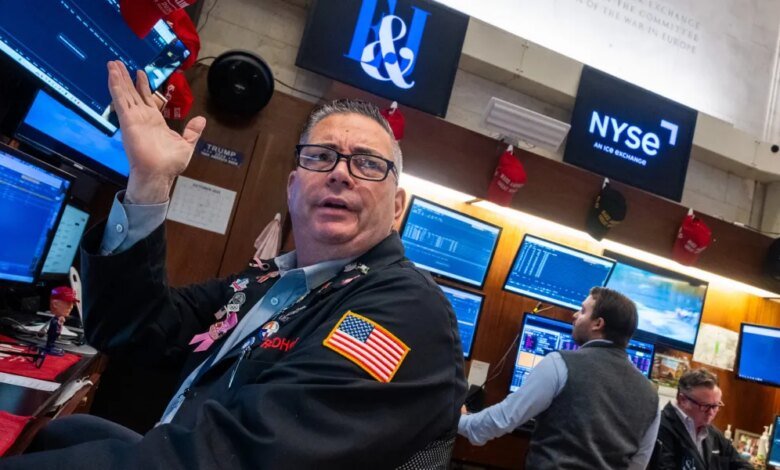Rattled Wall Street on alert after trillion-dollar risk runup

After two months of market bliss, Wall Street is waking up from its slumber.
Initially, the collapse of First Brands Group and Tricolor Holdings revived long-dormant concerns about hidden credit losses. Then, fraud-related writedowns at Zions Bancorp and Western Alliance — wiping more than $100 billion off the value of U.S. bank stocks in a single day — raised concerns that lending pressures were becoming more widespread.
Until recently, investors ignored everything from government shutdowns to extended valuations, buoyed by the boom in artificial intelligence and resilient consumer data. This left the positioning looking aggressive. According to Société Générale, allocations to risky assets such as stocks and credit rose to 67% of portfolios tracked at the end of August – near peak levels.
Stocks still ended the week with nice gains, extending a bull market that had already added $28 trillion to its value, after president Donald Trump backed away from tariff threats last Friday. But six days of volatility across assets show a deeper concern taking hold: credit fragility. More than $3 billion flowed out of high-yield bond funds in the week through Wednesday, according to EPFR Global. Risk momentum trades like cryptocurrencies, which were previously untouchable, are also starting to lose steam.
In quantitative portfolios, strategies that hedge credit risk are re-emerging. Pair trading betting against highly leveraged companies — and supporting their low-leverage peers — is once again generating strong gains, echoing patterns seen before the dot-com peak, according to Evercore ISI.
None of these moves indicate a permanent bearish turn. But the tone has changed. Taken together — the resurgence of lax credit standards, the loss of leveraged companies, and speculative flows disconnected from fundamentals — echoes of past turning points are fueling a spirit of discipline among a group of big money managers.
John Rowe, head of multi-asset funds at Legal & General, which manages $1.5 trillion, said his team moved to reduce risk, citing a growing mismatch between investors’ positions and underlying fundamentals.
“In recent weeks, we have seen this as an underappreciated risk against a backdrop of high, although not extreme, investor sentiment,” Rowe said. “This was a key part of the decision to reduce risk appetite and short sell stocks on Wednesday.”
The company was already credit-underweight, citing tight spreads and limited upside. While the collapses of Tricolor and First Brands were widely viewed as an extraordinary event, Rowe’s team viewed them as potential warning signs of broader stress, especially among low-income borrowers.
Others had a similar idea.
“I think we are entering a classic credit contraction cycle,” said Ulrich Urban, head of multi-asset strategy and research at Berenberg. “It’s not catastrophic, but there is an increasing risk that it will mark a turning point in the broader environment.”
In the past two weeks, Orban said he added equity hedges, reducing his exposure to stocks by about 10 percentage points and becoming underweight. He sold call options on the S&P 500 to help fund protective bets, and even trimmed his positions in gold and silver — trades that became increasingly crowded.
“After the year-to-date performance, there is a lot of motivation to protect the strong gains,” he said.
Despite the credit concerns, the S&P 500 finished the week up 1.7% even as the S&P Select Regional Bank Index fell nearly 2% in its fourth straight week of losses. Spreads on high-yield corporate bonds, although still historically tight, widened by 0.25 percentage point this month to 2.92 percentage points. The VVIX index — or volume, which tracks the speed of shifts in investor sentiment — reached its highest level since April. The measure of demand for risk insurance also jumped to the highest level in six months.
The drive towards risky assets was not driven by confidence alone. For active managers, 2025 looks to be one of the worst years on record, with the proportion of long-only actively managed funds falling to 22% in 2025, according to data from Jefferies Financial Group Inc. This pressure has intensified the chase for what works — even as fundamentals have deteriorated.
On the far edge of the risk spectrum, cryptocurrencies failed to rebound after losing $150 billion last Friday. Unlike previous crashes, there was no retail rush to buy the dip – just silence. This restriction, despite low interest rates and declining liquidity, signals a shift: less mania, more risk control. The cooling could spread beyond tokens.
Not everyone sees the recent tremors as a turning point.
The sell-off associated with Zions and Western Alliance looks more like an overreaction to isolated stress than a sign of a deeper credit squeeze, said Garrett Melson, portfolio strategist at Natixis Investment Managers Solutions.
“This probably speaks more about the situation and feelings than anything else,” he said. While spreads are tight, Melson still sees strong fundamentals and solid credit. His team recently moved from slightly underweight the stock to neutral. “Neutrality seems to be a good way to position yourself, so you have a better chance of leaning more strongly toward weight gain,” he said.
2025-10-17 21:05:00




